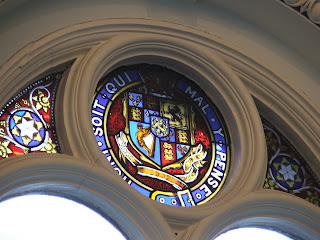News from the Archive – Queen Victoria’s visit to Ireland, April 1900
To mark the occasion of Queen Elizabeth II's historic visit to Ireland, I thought it might be interesting to look in the archive to see what the College did the last time a reigning British Queen came to Ireland – Queen Victoria's visit in April 1900, captured on film by Pathé News:
QUEEN VICTORIA IN DUBLIN, 1900
As a Royal College there had always been a strong tradition of support within the College for the British monarchy, which is expressed in the design of the College's building on Kildare Street. Built in the 1860s the interior design includes a stained glass window showing the Royal Coat of Arms, and plaster work moulding with the Queen's monogram VR.
 |
| Stained glass window with Royal coat of arms, Graves Hall, RCPI |
The College's loyalty to the British monarchy in the nineteenth century can also be traced in the archive, which contains a number of draft loyal addresses to various Royals and Lord Lieutenants of Ireland, including an address to Queen Victoria on the occasion of her son's marriage (RCPI/2/3/4/2) and letter from the Queen's household thanking the College for their loyal address after an attempt on the life of another son, Alfred, Duke of Edinburgh and of Saxe-Coburg and Gotha (RCPI/2/3/4/4).
In 1900 the College again offered a loyal address to Queen Victoria, on the occasion of her visit to Dublin, the full text of which is recorded in the College Journals (or minute books). Having opened with an eloquent flourish of titles and congratulations the address went on to state that;
'As physicians we recognise with grateful appreciation the favour which your Majesty has ever extended to our Profession, and the kindly interest you have taken in its efforts for the advancement of Medical Science as well as the preservation and improvement of the Health of the Nation. On our part, we have on all occasions striven to further these great interests, which have been entrusted to us both by your Royal Predecessors and by your Gracious Majesty, in the successive Charters of our College.'
'We are deeply and gratefully sensible of the generous impulse which has prompted your Majesty at this time to visit Ireland, and its capital – a gracious recognition of the heroic and conspicuous part which your Majesty's Irish troops have played in the War in South Africa. In this season of trouble you have – as you have ever done – made the trials and sorrows of your people your own, thus drawing their thoughts and hearts ever closer to your Royal Person by ties of affectionate regard.'[1]
The Irish medical profession had made its own contributions to the war in South Africa, with several Irish medics serving with the British Army. Most notably the Irish surgeon Sir William Stokes, son of a former President of the College of Physicians, who at the age of 60 had gone out as consulting surgeon to the British forces. While in South Africa, Stokes contracted pleurisy, he died in August 1900 and was buried at Fort Napier, Natal.
Sir William Stokes (1839-1900) and his grave in South Africa, MSA/6/2
As well as presenting their address to Queen Victoria, the College also honoured her personal physician Sir James Reid. Sir John Banks a Fellow of the College nominated Reid for an Honorary Fellowship, a decision which was passed unanimously by the College Fellows. Reid was awarded his Honorary Fellowship on 6th April.
 |
| Sir James Reid, 1901 |
Reid had been a member of Queen Victoria's household for almost twenty years, starting in 1881 as Resident Medical Attendant and eventually rising to Physician-in-Ordinary to the Queen. Following Queen Victoria's death in 1901, at which he was in attendance, Reid remain Physician-in-Ordinary to her son Edward VII, whose death he also witnessed, and her grandson George V. Reid himself died in 1923 at the age of 73.[2]
References:
[1] College Journal - Vol. XXII, RCPI/2/1/1/24
[2] Sir James Reid - Royal Apothecary by Michaela Reid, Joural of the Royal Society of Medicine, 2001, http://www.ncbi.nlm.nih.gov/pmc/articles/PMC1281397/